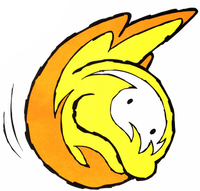Lava Drop: Difference between revisions
From the Super Mario Wiki, the Mario encyclopedia
Jump to navigationJump to search
m (Text replacement - "<references/> {{" to "<references/> {{") |
m (Text replacement - "{{[Ss]pecies-infobox" to "{{species infobox") |
||
| Line 1: | Line 1: | ||
{{distinguish|Lava Bubble}} | {{distinguish|Lava Bubble}} | ||
{{ | {{species infobox | ||
|image=[[File:Lavadrop.png|200px]] | |image=[[File:Lavadrop.png|200px]] | ||
|first_appearance=''[[Super Mario World 2: Yoshi's Island]]'' ([[List of games by date#1995|1995]]) | |first_appearance=''[[Super Mario World 2: Yoshi's Island]]'' ([[List of games by date#1995|1995]]) | ||
Revision as of 21:30, April 20, 2022
- Not to be confused with Lava Bubble.
| Lava Drop | |||
|---|---|---|---|

| |||
| First appearance | Super Mario World 2: Yoshi's Island (1995) | ||
| Latest appearance | Poochy & Yoshi's Woolly World (2017) | ||
| Variant of | Cloud Drop | ||
| |||
Lava Drops are small, floating, fireball-like enemies found in Super Mario World 2: Yoshi's Island, Yoshi's Island: Super Mario Advance 3, Yoshi's New Island, Yoshi's Woolly World and Poochy & Yoshi's Woolly World, seemingly resembling Lava Bubbles from Mario games. They move either up and down, or left and right. The player cannot destroy them with regular attacks, and as a result, they have to be avoided completely. They appear in various cave levels and in groups. They can be defeated by passing through a Checkpoint Ring, using a Winged Cloud item or with an Anywhere POW.
Gallery
- SMW2YI Lava Drop Sideways.png
Super Mario World 2: Yoshi's Island
Names in other languages
| Language | Name | Meaning |
|---|---|---|
| Japanese | ファイアおたま[1][2] Faia Otama |
From "fire" and「おたま」(Otama, Cloud Drop) |
| German | Lava-Drossel[citation needed] Lava-Schleimi (Yoshi's Woolly World) |
Lava Thrush Lava Slime (Yoshi's Woolly World) |
| Italian | Goccia di Lava[citation needed] Magmagoccia (Yoshi's Woolly World) |
Lava Drop Magmadrop (Yoshi's Woolly World) |
| Spanish (NOA) | Gota de lava |
Lava Drop |
References
| Lava Bubbles | |
|---|---|
| Species | Big Lava Bubble • Black Lava Bubble • Bō • Ember • Lava Babble • Lava Blubble • Lava Bubble • Lava Ghost • Paper Macho Lava Bubble • Phantom Ember • Podoboo Tower • Poison Bubble |
| Relatives | Fire Bar • Fire Snake • Fireball (Donkey Kong) • Lava Blobble |


